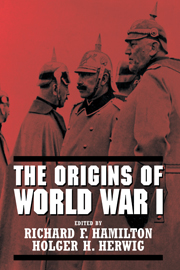Book contents
- Frontmatter
- Contents
- List of Tables and Maps
- Contributors
- Acknowledgments
- 1 World Wars: Definition and Causes
- 2 The European Wars: 1815–1914
- 3 Serbia
- 4 Austria-Hungary
- 5 Germany
- 6 Russia
- 7 France
- 8 Great Britain
- 9 Japan
- 10 The Ottoman Empire
- 11 Italy
- 12 Bulgaria, Romania, and Greece
- 13 The United States
- 14 Why Did It Happen?
- 15 On the Origins of the Catastrophe
- Appendix A Chronology, 1914
- Appendix B Dramatis Personae
- Appendix C Suggested Readings
- Index
13 - The United States
Published online by Cambridge University Press: 05 August 2012
- Frontmatter
- Contents
- List of Tables and Maps
- Contributors
- Acknowledgments
- 1 World Wars: Definition and Causes
- 2 The European Wars: 1815–1914
- 3 Serbia
- 4 Austria-Hungary
- 5 Germany
- 6 Russia
- 7 France
- 8 Great Britain
- 9 Japan
- 10 The Ottoman Empire
- 11 Italy
- 12 Bulgaria, Romania, and Greece
- 13 The United States
- 14 Why Did It Happen?
- 15 On the Origins of the Catastrophe
- Appendix A Chronology, 1914
- Appendix B Dramatis Personae
- Appendix C Suggested Readings
- Index
Summary
In April 1917, the United States entered World War I on the side of the Allies. Ever since then, people have been arguing about why this happened and what to make of it. Most of the combatants who have entered the fray have been Americans. These verbal warriors have included not only historians, but also journalists and other writers and even, at times, politicians. Their conflict grew most intense, curiously, not immediately following the war nor in the first decade afterward. Rather, it was in the 1930s, as Americans confronted the breakdown of international order and the approach of what became World War II, that intervention in World War I retrospectively became a hot political and intellectual issue. Since that time, the argument has largely subsided and has usually involved only a coterie of historians. During all of these decades, few people on the other side of the Atlantic have taken much interest in the subject, with a few interesting and significant exceptions from time to time among certain Britons and more recently among the Germans.
Remarkably, for an argument that lasted so long and once involved so much passion, this one took place within a constricted conceptual framework. That framework really consisted of two propositions. One was that the only point worthy of contention was approval or condemnation of intervention. Was it a good thing or a bad thing? Did it spring from noble or sordid motives?
- Type
- Chapter
- Information
- The Origins of World War I , pp. 415 - 442Publisher: Cambridge University PressPrint publication year: 2003
- 1
- Cited by



